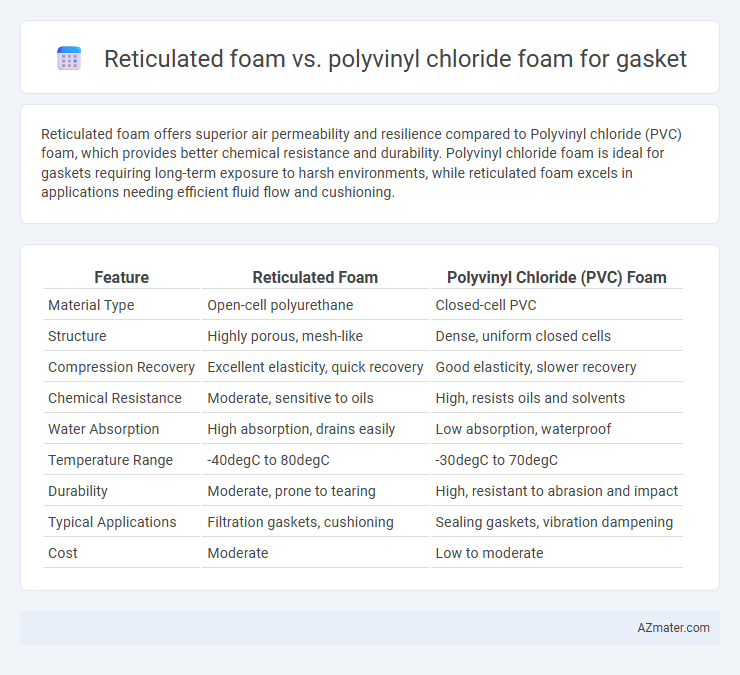Reticulated foam offers superior air permeability and resilience compared to Polyvinyl chloride (PVC) foam, which provides better chemical resistance and durability. Polyvinyl chloride foam is ideal for gaskets requiring long-term exposure to harsh environments, while reticulated foam excels in applications needing efficient fluid flow and cushioning.
Table of Comparison
| Feature | Reticulated Foam | Polyvinyl Chloride (PVC) Foam |
|---|---|---|
| Material Type | Open-cell polyurethane | Closed-cell PVC |
| Structure | Highly porous, mesh-like | Dense, uniform closed cells |
| Compression Recovery | Excellent elasticity, quick recovery | Good elasticity, slower recovery |
| Chemical Resistance | Moderate, sensitive to oils | High, resists oils and solvents |
| Water Absorption | High absorption, drains easily | Low absorption, waterproof |
| Temperature Range | -40degC to 80degC | -30degC to 70degC |
| Durability | Moderate, prone to tearing | High, resistant to abrasion and impact |
| Typical Applications | Filtration gaskets, cushioning | Sealing gaskets, vibration dampening |
| Cost | Moderate | Low to moderate |
Overview of Reticulated Foam and Polyvinyl Chloride (PVC) Foam
Reticulated foam features an open-cell structure that provides excellent airflow, drainage, and filtration, making it suitable for gaskets requiring breathability and rapid moisture dissipation. Polyvinyl chloride (PVC) foam offers a closed-cell configuration with superior chemical resistance, durability, and compression recovery, ideal for gaskets exposed to harsh environments and mechanical stress. Both materials differ in porosity and resilience, influencing their performance and application in sealing and cushioning tasks.
Key Material Properties of Reticulated Foam
Reticulated foam features an open-cell structure that allows excellent air and liquid flow, making it highly breathable and resistant to moisture retention compared to closed-cell Polyvinyl chloride foam. Key material properties include high porosity, low density, and superior compression recovery, which enable effective cushioning and filtration in gasket applications. These characteristics provide enhanced durability and environmental resistance, particularly in applications requiring fluid drainage and rapid drying.
Key Material Properties of Polyvinyl Chloride (PVC) Foam
Polyvinyl chloride (PVC) foam exhibits excellent chemical resistance, durability, and weatherability, making it a preferred choice for gaskets requiring long-term exposure to harsh environments. Its closed-cell structure provides superior compressibility and resilience, ensuring effective sealing performance under varying pressure and temperature conditions. Compared to reticulated foam, PVC foam offers enhanced mechanical strength and moisture resistance, critical for maintaining gasket integrity in industrial applications.
Performance Differences in Gasket Applications
Reticulated foam offers superior breathability and water drainage, making it ideal for gaskets requiring ventilation and rapid moisture evacuation, while polyvinyl chloride (PVC) foam provides enhanced chemical resistance and mechanical durability, suitable for sealing applications exposed to harsh chemicals and physical stress. Reticulated foam's open-cell structure ensures low compression set and excellent cushioning under dynamic loads, whereas PVC foam's closed-cell configuration delivers better resistance to deformation and aging in static seal environments. Performance differences in gasket applications hinge on specific requirements: reticulated foam excels in filtration and cushioning roles, whereas PVC foam is favored for robust sealing durability and chemical resilience.
Compression Set and Recovery Comparison
Reticulated foam exhibits superior recovery rates and lower compression set compared to polyvinyl chloride (PVC) foam, making it ideal for gaskets requiring resilience under repetitive compression. PVC foam tends to have higher compression set values, indicating permanent deformation after prolonged stress, which can compromise the seal's effectiveness over time. The open-cell structure of reticulated foam facilitates better shape memory and durability, enhancing gasket performance in dynamic sealing applications.
Chemical and Environmental Resistance
Reticulated foam offers superior chemical resistance due to its open-cell structure, allowing rapid drainage and minimal chemical absorption, making it ideal for applications involving aggressive solvents and acids. Polyvinyl chloride (PVC) foam provides excellent resistance to oils, fuels, and moderate chemicals with durable environmental stability against UV and ozone exposure. In terms of environmental resistance, reticulated foam excels in applications requiring breathability and quick drying, while PVC foam stands out for long-term durability and weather resistance in gasket sealing.
Durability and Longevity for Gasket Use
Reticulated foam offers superior durability with an open-cell structure that resists compression set and maintains flexibility under repeated stress, making it ideal for gaskets exposed to dynamic environments. Polyvinyl chloride (PVC) foam provides excellent chemical resistance and weathering stability, contributing to its long lifespan in gasket applications where exposure to oils, solvents, and UV radiation is common. Both foams enable effective sealing solutions, but reticulated foam excels in resilience and longevity for high-performance gasket demands.
Cost Considerations and Availability
Reticulated foam offers lower cost options due to its open-cell structure allowing for efficient material use, but availability can be limited depending on specific density and porosity requirements. Polyvinyl chloride (PVC) foam provides consistent pricing and high availability as it is widely manufactured and used in gasket applications, benefiting from established supply chains. Cost considerations lean towards reticulated foam for budget-sensitive projects, while PVC foam remains preferable when uniform availability and material performance consistency are critical.
Typical Industry Use Cases and Applications
Reticulated foam is ideal for filtration, cushioning, and sound absorption in automotive and HVAC gasket applications due to its open-cell structure that allows fluid and air flow. Polyvinyl chloride (PVC) foam is commonly used in sealing and insulation gaskets within construction and electrical industries, offering durability, chemical resistance, and water impermeability. These contrasting properties make reticulated foam suitable for breathable and lightweight gaskets while PVC foam excels in providing robust, weather-resistant seals.
Choosing the Right Foam for Your Gasket Needs
Reticulated foam offers superior open-cell structure, enhancing breathability and drainage, making it ideal for applications requiring fluid filtration or cushioning with air flow. Polyvinyl chloride (PVC) foam provides excellent chemical resistance, durability, and compressibility, making it suitable for sealing and insulation in harsh environments. Selecting the right foam depends on environmental exposure, required compression set, and specific gasket performance criteria such as resistance to oils or UV degradation.

Infographic: Reticulated foam vs Polyvinyl chloride foam for Gasket
 azmater.com
azmater.com